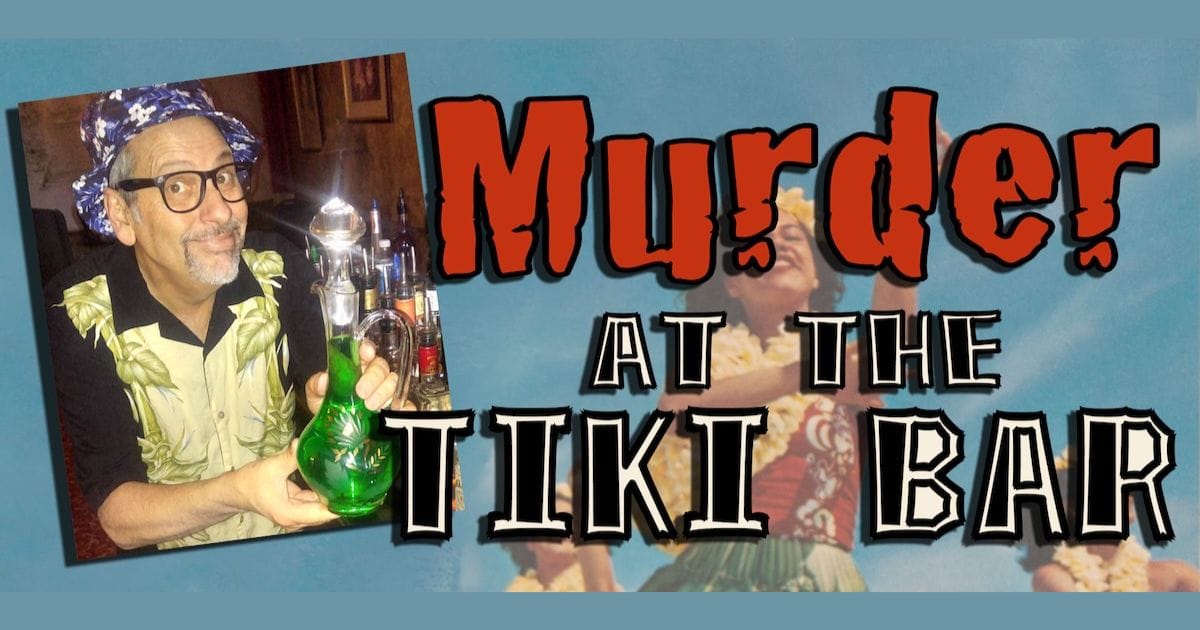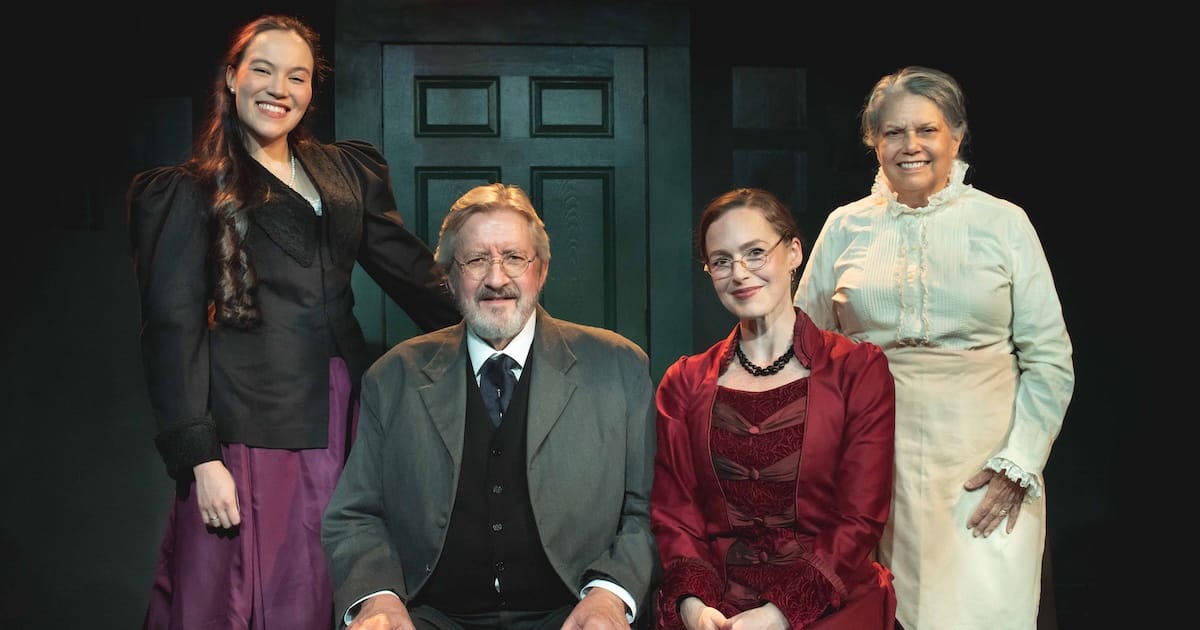From OpenStage, ‘Reefer Madness’ brings a fresh twist on marijuana propaganda musical
Entering the theater for Reefer Madness, the audience is instantly swept into the playful, satirical tone of this outlandish production. Adapted from the 1936 propaganda film that wildly exaggerated the dangers of marijuana, this musical tackles America’s historical fearmongering around cannabis with a clever mix of comedy, camp and toe-tapping tunes.
Before the show even begins, the stage is set with a vibrant, immersive atmosphere, complete with a fog machine making the room extra hazy. The green-tinged lights illuminating a leafy, hazy curtain immediately hint at the “dangerous” allure of marijuana, while a podium emblazoned with a school emblem and motivational posters reminds us of the 1930s morality that the show seeks to satirize.
Pre-show warnings
The interactive pre-show experience — where actors roam the crowd warning of the horrors of “the marijuana” — adds a small-town rally feel. These touches establish the sense that we’re in for a tongue-in-cheek theatrical journey that gleefully mocks outdated moral panics.
The musical opens with Jimmy Harper and Mary Lane, two wholesome, all-American teens unwittingly lured into the world of marijuana by the shady Jack Stone. As the “reefer madness” consumes them, their lives spiral into a surreal blend of jazz music, sex and violence.
With each new calamity, the musical pokes fun at the original film’s absurd warning against marijuana, revealing how the characters’ lives are thrown off course by the plant. What unfolds is an over-the-top cautionary tale about the “evils” of cannabis, full of ironic twists and comical, melodramatic scenes that lampoon outdated views on morality and addiction.

Aubrey Renee Photography
Standouts
Standout performances help make Reefer Madness memorable, starting with Brian Wilcox, who shines as the intense, often ridiculous Lecturer. His role as the show’s moral anchor quickly becomes a vehicle for hilarity as he delivers dire warnings and slips between a myriad of supporting characters. He makes them distinct with absurdly exaggerated accents, keeping the audience laughing throughout.
Alex Forbes is a standout as Mae, infusing the character with a blend of vulnerability and outrageous humor that makes her impossible to ignore. Her exaggerated facial expressions, dynamic physicality and bold reactions to the chaos around her command attention, allowing her to steal every scene she’s in.
Henry Hawes and Nicole Gardner provide a solid anchor as Jimmy and Mary, infusing the central couple with charm and vocal prowess, while Mikeal Macbeth’s memorable portrayals of the villainous Jack Stone, an outrageous Jesus and a pompous George Washington are delightfully absurd.
Madness and innocence
Director Kenny Moten brings his expertise to staging the show’s comedic moments, balancing exaggerated humor with genuine emotional stakes for the characters. Moten smartly establishes the small-town atmosphere of 1930s America, playing up the innocence of Jimmy and Mary, which makes their descent into “madness” all the more absurd and comical.
By focusing on the interpersonal relationships, Moten ensures the comedy doesn’t overshadow the characters’ stakes, making their journey surprisingly engaging even as it descends into satire. His attention to these dynamics brings out the heart in the midst of chaos, creating a grounded, relatable core that bolsters the show’s humor.
The choreography by Jessica Hindsley is a delightful highlight, bringing a spirited, campy edge that perfectly complements the show’s satirical tone. The ensemble executes each number with infectious energy, embodying the exaggerated, jazz-infused world of Reefer Madness with precision and humor. From high-energy group numbers to smaller, more ridiculous dance breaks, the ensemble commits fully, adding layers of visual comedy to the musical’s wild storyline.
The set design by Caleb Gilbert adds an inventive, immersive quality to the production, using rotating panels and minimalist props to transform the stage seamlessly from a school assembly hall to a smoky jazz club.
The choice to rely on these flexible, understated elements works brilliantly, allowing each scene to flow easily while highlighting the performers. In one memorable sequence, a single pew rolls across the stage during Mary’s fantasy, a clever staging choice that captures the production’s spirit of inventive simplicity.
Challenges
However, not everything hits the mark. The interactive staging, though ambitious, presents visibility challenges, particularly for audience members seated near the front, who miss out on certain scenic elements — like the giant joint that makes a surprise appearance overhead.
During scenes played within the audience, those in the front rows must turn around fully, occasionally missing key moments. Additionally, the lighting design, though vibrant, suffers from occasional awkward shadows that obscure the actors.
Despite these technical shortcomings, the production’s creativity and energy shine through, making it easy to forgive some of the rough edges. While Reefer Madness may not have drawn a full house on opening night, the energy and talent of the cast, along with the production’s ambitious, interactive staging, make it an experience worth seeing.
Ultimately, OpenStage Theatre & Company’s Reefer Madness is a wild, campy thrill ride that offers an enjoyable balance of humor and theatrical innovation. Though some technical elements may need refining, Moten and his team demonstrate a love for satire and a commitment to pushing the boundaries of interactive theater.
A Colorado-based arts reporter originally from Mineola, Texas, who writes about the evolving world of theater and culture—with a focus on the financial realities of making art, emerging forms and leadership in the arts. He’s the Managing Editor of Bucket List Community Cafe, a contributor to Boulder Weekly, Denver Westword and co-host of the OnStage Colorado Podcast. He holds an MBA and an MA in Theatre & Performance Studies from CU Boulder, and his reporting and reviews combine business and artistic expertise.










Leave A Comment